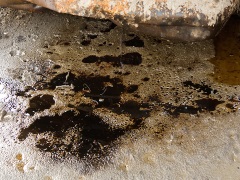Features
Oil, ash and microbes
Date: 2019-02-28 12:17:37.0
Author: Jon Evans

Natural materials have already shown quite a bit of potential for clearing up oil spills, both on land and in the water. This is because natural materials such as sawdust and straw are not only naturally absorbent but can also readily be physically or chemically modified to enhance their absorption of oil (see Nature’s way for cleaning up oil spills).
For example, scientists have shown that a very fine version of sawdust known as wood flour, chemically modified with components of vegetable oil to make it water-repelling, can absorb oil from freezing water, which is particularly challenging. Other scientists have shown that an aerogel created by heating and then freeze-drying lettuce can be used for continuously soaking up oil from water (see Clearing up oil with flour and lettuce).
But absorption is merely the first step, because the absorbent material then needs to be collected and disposed of, in order to remove the oil from the environment. It would be much better if the natural absorbent could simply break the oil down after absorbing it, transforming the oil from a toxic pollutant into harmless chemicals. It would also be handy if the absorbent was a waste material that is already produced in large quantities, rather than having to be specially created, which adds expense.
This is what a team of Chinese scientists, led by Zhantao Han at the Chinese Academy of Geological Sciences’ Institute of Hydrogeology and Environmental Geology, has now managed to achieve. The scientists have shown that the ash produced from burning biomass in power stations, known as biofuel ash, makes an ideal medium for housing oil-degrading microbes.
As an increasing number of power plants are shifting from burning coal to burning biomass, the amount of biofuel ash produced is steadily growing, leading scientists to try to find uses for it. One of the main components of this ash is silicon, which can be extracted and used to produce catalysts (see Ashes to catalysts), but other major components include calcium, magnesium and potassium, all of which are important nutrients for microbes. The ash is also naturally absorbent, which made Han and his colleagues wonder whether it could prove useful for clearing up oil from soil.
The idea is that the ash would absorb oil from the soil, with the absorbed oil acting as a food source for oil-degrading microbes incorporated into the ash. As an added bonus, the ash would help physically protect the microbes and also provide them with essential nutrients. To boost this degradation process, Han and his colleagues tried reacting the biofuel ash with a solution of humic acid, which is a natural surfactant that makes oil more soluble, thereby enhancing the availability of the oil-derived hydrocarbons to the microbes.
The scientists tested this microbe-containing modified biofuel ash on oil-contaminated soil collected from an oil refinery in China, comparing the ash with the oil-degrading microbes on their own. As they report in a paper in the Journal of Chemical Technology and Biotechnology, the modified biofuel ash degraded oil in the soil at twice the rate of the free microbes. This shows the benefits of housing the microbes within the ash, which helps to protect them against both harsh soil conditions and indigenous microbes in the soil.
After 60 days, the microbes in the ash had degraded almost 50% of the oil-derived hydrocarbons in the soil, including most of the medium- and long-chain alkanes. By monitoring the respiration rate of the microbes, Han and his colleagues confirmed that they appeared to break down the easily digested hydrocarbons first before moving on to the less easily digested hydrocarbons. This suggests that, eventually, the microbes might be able to break down all the oil in contaminated soil. To find out for sure, the scientists will need to test their microbe-containing modified ash on large areas of contaminated soil out in the field, which they are now planning to do.
The views represented here are solely those of the author and do not necessarily represent those of John Wiley and Sons, Ltd. or of the SCI.
This article has not been tagged with keywords.
